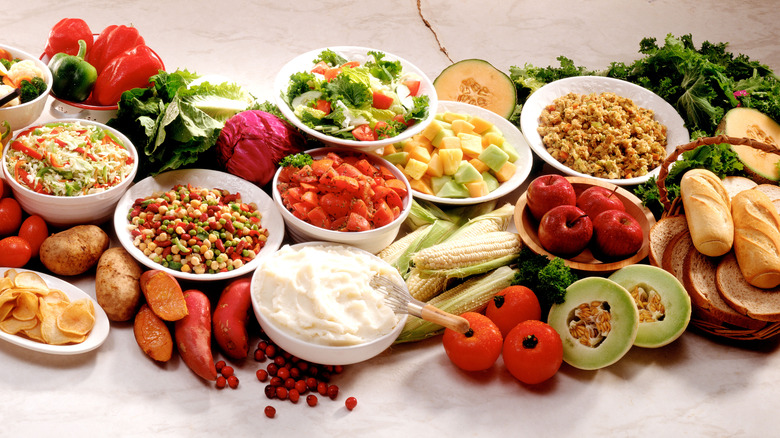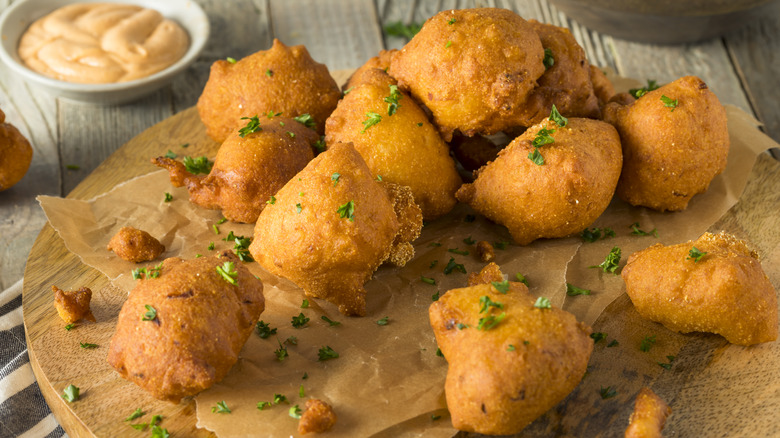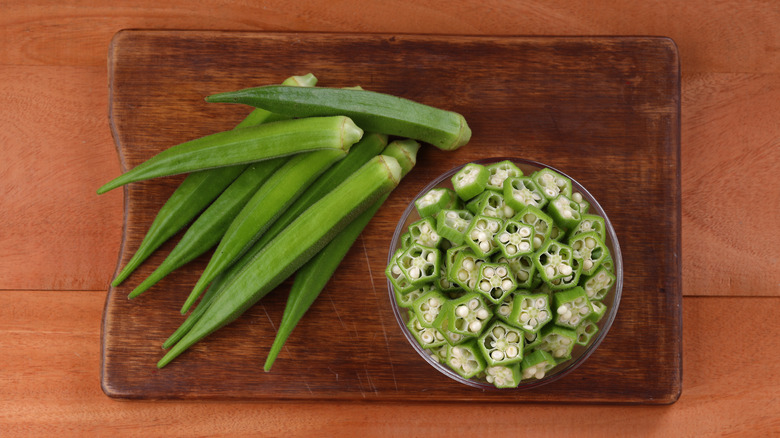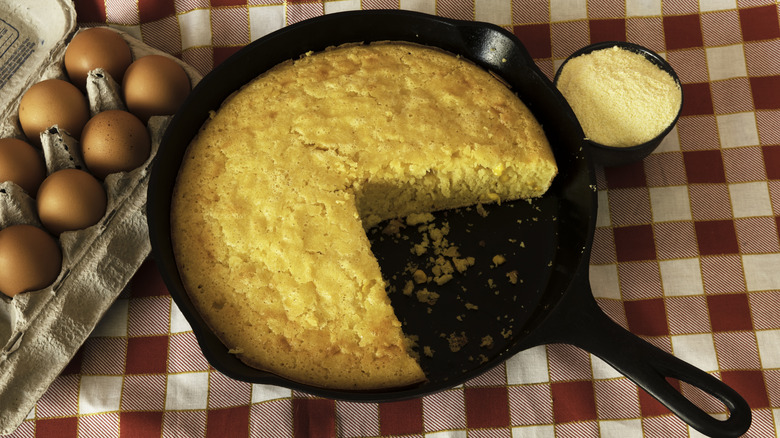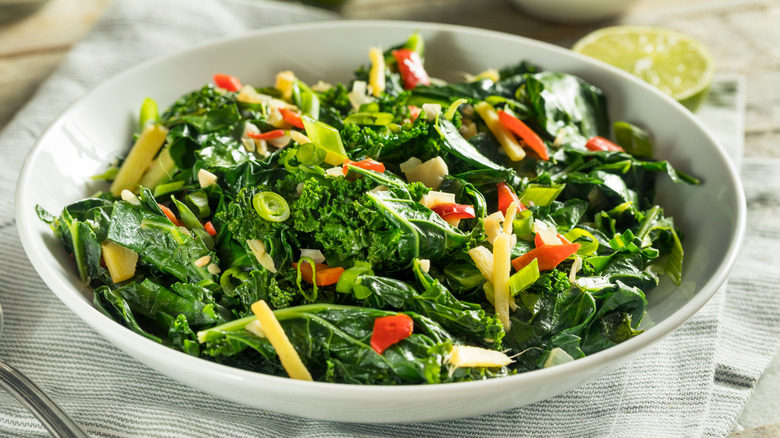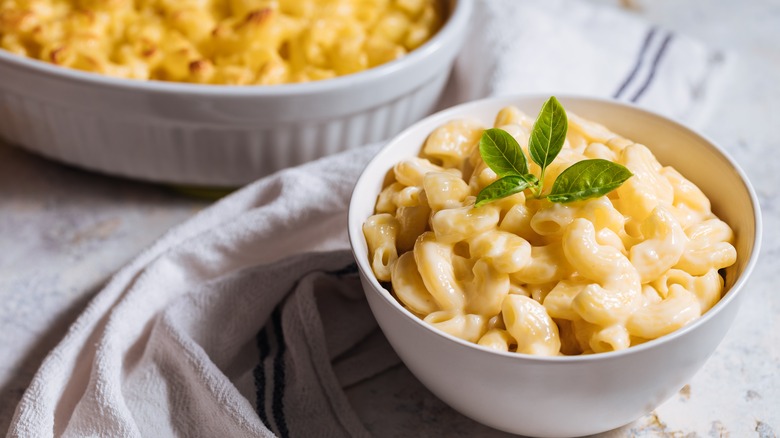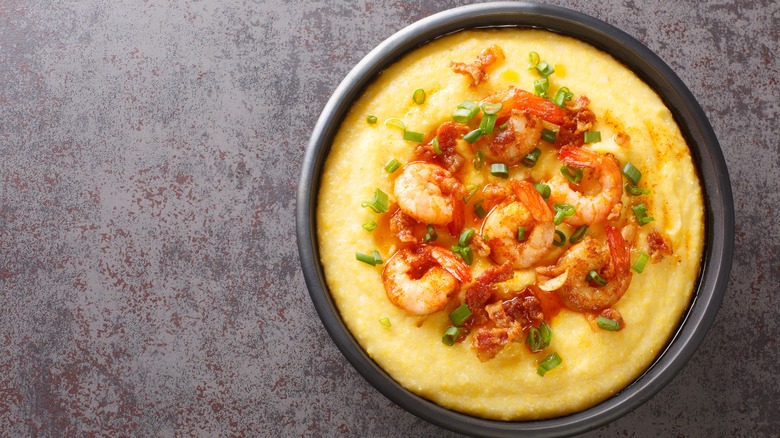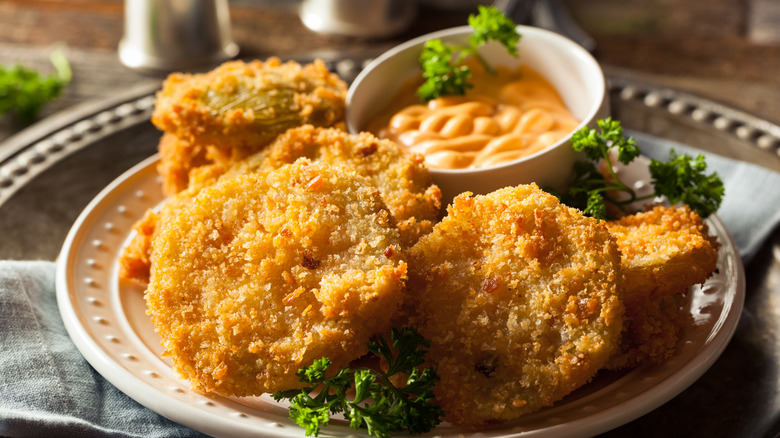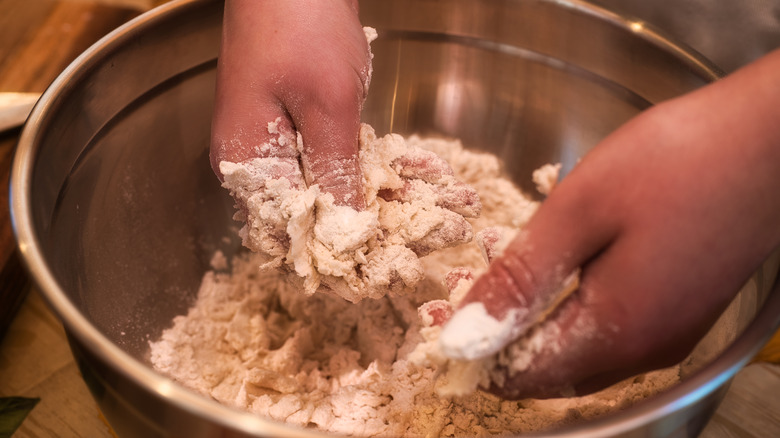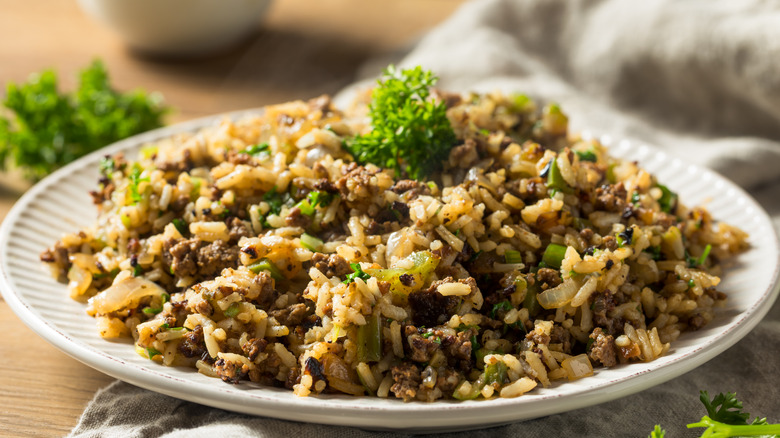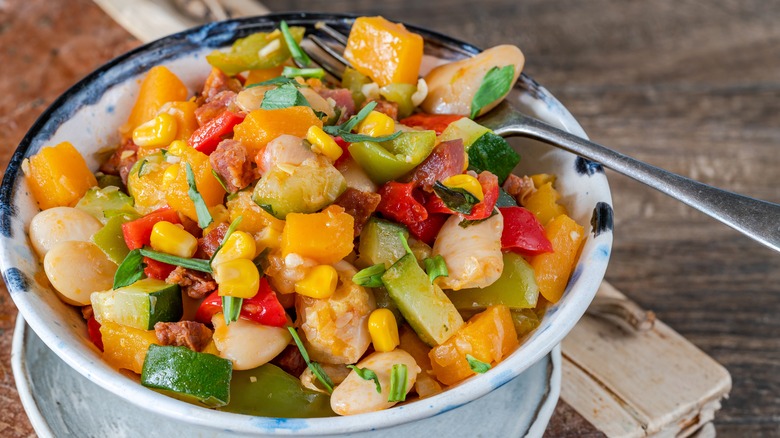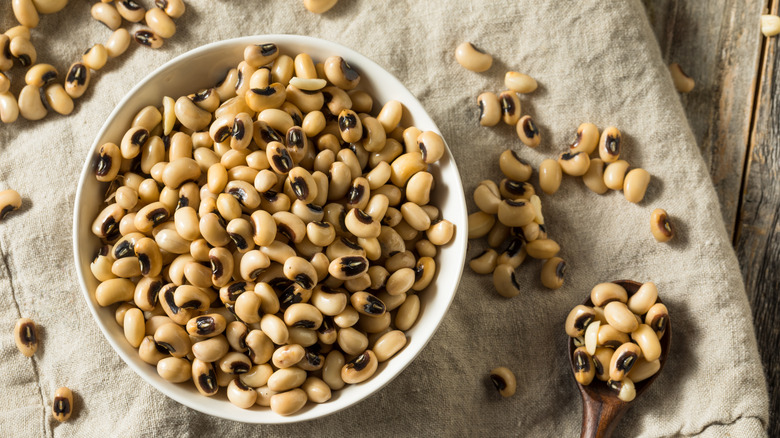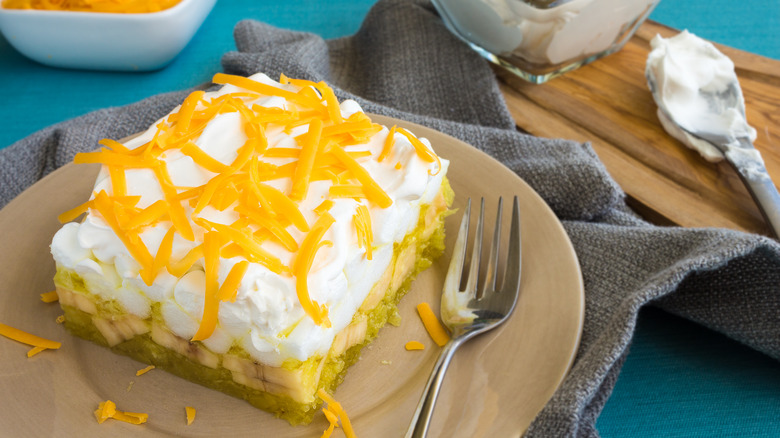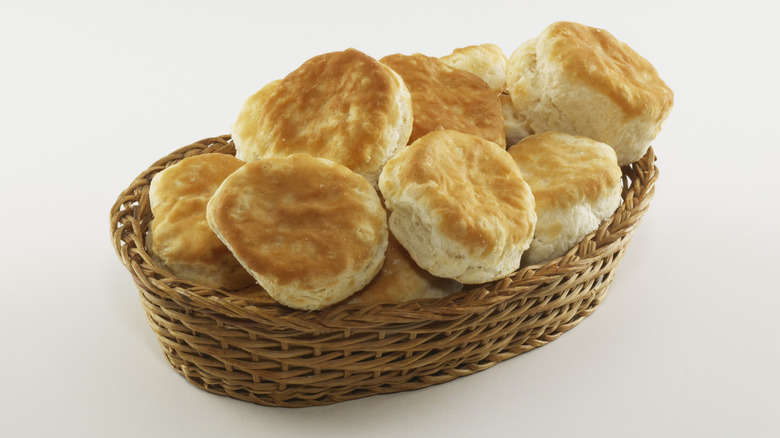13 Best Southern Side Dishes You Need To Try At Least Once
Southerners arguably make some pretty serious cultural connections through food. Certainly, nothing quite says Southern hospitality like a table full of homemade soul food. As far as regional cuisine goes, Southern food is seriously iconic, with staple dishes that are featured seemingly everywhere in the region and beyond, from cookbooks to grandma's kitchen to fine dining restaurants.
While the main course is usually the showstopper of any meal (in the South, that could take the form of fried chicken, baby back ribs, or roasted ham), a Southern feast would be woefully insufficient without side dishes to make the meal whole. Classics like fried green tomatoes, hushpuppies, grits, and okra help to make southern cooking memorable and distinct.
We've rounded up a list of our favorite Southern side dishes that we recommend trying at least once. These dishes are not only delicious but deeply rooted in history and the culture of the South as well. As a nod to the diverse ancestors who made these recipes what they are today, give this list a try in your kitchen or on your next trip down south.
Hushpuppies
Also known as three finger bread or corn dodgers, hushpuppies are deep-fried balls of cornmeal. Although hushpuppies are a delightfully crunchy southern side dish, the history of the hushpuppy ranges farther afield. The particulars depend on the source, as there are many different origin stories. One tale claims that hushpuppy used to refer to the liquid left in the pot after boiling beans or greens. Meat and seasonings were added to this hushpuppy liquid to create soup. Making the soup reportedly kept dogs from growling, either literally or in reference to the rumbling of an empty stomach.
As with many foods that are synonymous with the south, hushpuppy recipes are inspired by the culinary practices of indigenous people, many of whom used cornmeal alongside fish dishes. Others believe hushpuppies were the creation of a renowned fish fry chef and emancipated slave, Romeo Govan. His famous red horse cornbread is the first documented recipe that includes the ingredients and resembles the process of making hushpuppies as we know them today.
If you're not in the South and don't have access to an establishment that features hushpuppies on the menu, you can make them at home. Even better, they can come together with a few basic ingredients that you likely already have in your pantry, including cornmeal, flour, salt, baking powder, baking soda, an egg, and some oil. Dip them in any of your favorite sauces, preferably something with a little kick of spice to give it that unique Southern flair.
Fried okra
Few things are more rooted in Southern history than fried okra. Okra pods, which are best when harvested during the summer season, are a green vegetable that likely originated in Nigeria. The technique of frying it likewise appears to have emerged from West Africa. Fried okra is either sliced lengthwise or into rounds depending on the chef preparing it, but most would agree that it's best not to overcomplicate the recipe.
Battered in cornmeal and deep fried, it's important to still taste the okra. The texture is also an important factor when preparing okra. Many southern cooks prefer to use fresh okra as opposed to frozen, to yield the best flavor and consistency.
If you're not in the South and have never tried okra, it may be intimidating to attempt a fried batch of this tasty side dish or appetizer, especially given its reputation for sliminess. But with only four basic ingredients in a classic fried okra recipe, it's less threatening than one might think. Simply gather up some freshly diced okra, oil, salt, and pepper, and pop it into a deep fryer. Make it a bit more southern by coating the okra in cornmeal before placing it in the deep fryer.
Cornbread
Corn is a staple of the Southern diet thanks to its agricultural popularity and the many ways in which to cook this grain. Frankly, no Southern meal or barbecue would be complete without a side of homemade cornbread. With a crunchy exterior, soft interior, and salty-sweet taste, cornbread isn't just for Thanksgiving, it's a year-round component of any meal in the South. Many Southerners consider cornbread to be nothing less than an integral part of their identity, with treasured family recipes being passed down from one generation to the next.
While some northerners may be tempted to grab a box of cornbread mix from the store, the best cornbread is always homemade. It all starts with cornmeal. For your cornbread to be considered southern, you'll want to use white cornmeal and leave out the sugar and flour.
And while some northerners may revert to using regular milk, a true southern cornbread recipe calls for buttermilk. The last key component to true Southern cornbread is the use of a cast iron skillet. Many argue that it's best cooked over an open flame, but if you can't do so in your home, a regular oven will do.
Collard greens
Collard greens are somewhat of an acquired taste, but if you're from the south, odds are you like them just fine, especially when they have been sautéed. Collard greens are a leafy green from the brassica family, which includes cabbage, mustard greens, and turnips. As one of the darkest leafy greens, collard greens are rich in vitamins, minerals, and nutrients. They may even help stave off disease and prolong health, according to Healthline.
Collard greens originated in Europe, but it's likely that Africans forced into the European slave trade took their cooking skills and applied them to this hearty, fibrous vegetable, which then became popular in the South.
Today, the bulk of collard green production in America still takes place in the South, making this crop a popular side dish around many a Southern dinner table. They're often consumed on New Year's Eve to achieve prosperity in the year ahead, but they're also a staple year-round, especially when served with pork and black-eyed peas.
Macaroni and cheese
Can you call yourself a Southerner if you don't know your grandmother's mac and cheese recipe by heart? Many a southern cook maintains that this dish has to be homemade. The more cheese and butter involved, the better. As rich as macaroni and cheese may be, its history is even richer.
Originating in Italy, macaroni and cheese made its way to France by way of Catherine de Medici, and the French put a gruyere twist on the original parmesan macaroni. When Thomas Jefferson and his enslaved chef, James Hemmings, were in France on a diplomatic mission, Hemmings reportedly learned the recipe for macaroni and cheese. He brought it back to the States, where he would prepare the dish for wealthy politicians including 19th-century socialite Mary Randolph. Randolph became the first Southern woman to publish a cookbook, 1824's "The Virginia House-Wife," which included now-classic Southern recipes like macaroni and cheese. This popularized the dish and cemented it in Southern culture.
Grits
Grits are to the south as wine is to Napa Valley. The ground-up cornmeal can even taste differently, depending on the region where the corn was grown. While this dish has a muddy history in southern culture, it's also a gateway to understanding how the food traditions there have evolved over the years.
Grits were once largely consumed by poor Southerners and American Indians, who cooked it out of necessity. A rise in popularity has now made this low-class meal a staple in many restaurants in the South and beyond, where chefs often take inspiration from old recipes and modernize them into their unique creations.
But what grits, anyway? It consists of dried corn that has been ground in a meal. That's them cooked slowly in liquid — typically, broth, water, or milk — until it becomes creamy. Other ingredients like cheese, bacon, spices, butter, or sugar can elevate the flavor. The ultimate Southern pairing? Shrimp and grits, of course.
Fried green tomatoes
Among the most popular side dishes in southern cuisine is fried green tomatoes. These treats are so beloved in the South that writers and filmmakers have even named a book and movie adaptation after them. But the real, shocking truth is that fried green tomatoes are not inherently southern. These unripened and deep-fried tomatoes actually stem from the north, where they're believed to have been the creation of Jewish home cooks. It wasn't until "Fried Green Tomatoes" came out in 1991 that the dish became associated with Southern culture. The rest is history.
Though a red, juicy, and ripe tomato is one of nature's great creations, the only way to achieve the crunchy cornmeal exterior of a fried tomato is to start with green, unripe fruit. Once it's been deep-fried, the tangy flavor pairs well with the salty batter, making it a mouthwatering appetizer or side dish with any southern (or northern) entrée.
Spoonbread
Bread of any kind is always a popular choice in the South, whether it comes in the form of cornbread, biscuits, beignets, or Texas toast. A lesser-known yet still culturally significant bread in the South is spoonbread, perfected by Black southern cooks. With a texture akin to grits and a bite that's so decadent it resembles a cake, spoonbread is made with the southern staples of cornmeal, which is beaten together with sugar, milk, eggs, butter, and baking powder.
A recipe for spoonbread appeared in Mary Randolph's 1824 cookbook, "The Virginia House-Wife," which many chefs and historians regard as the original gateway to southern cooking. However, it likely was a popular household dish far earlier. Spoonbread, also known as batter bread, is soft enough to eat with a spoon but is not sweet enough to be called a dessert. Some chefs even add cheese to their spoonbread to give it a savory flavor.
Though it's not the most well-known side dish in the South and can be hard to find on a menu, spoonbread's historical relevance is deep-rooted and makes it a worthy opponent to more traditional cornbread.
Dirty rice
If you're a fan of one-pot meals, you need to add the southern staple of dirty rice to your repertoire. That is if you're not afraid of ground-up gizzards, liver, or heart, which typically accounts for the "dirty" portion of dirty rice. An essential side or main dish found in Louisiana, dirty rice is often made with long grain rice, sautéed onions, celery, and bell peppers. Many chefs also add hot sauce, spices, extra veggies, and whatever else they want to make their version of dirty rice.
Not all dirty rice consumed in the South today has ground-up chicken innards, as recipes have evolved. The origins of dirty rice stem from slave days, when enslaved people would be left with scraps of chicken, including the feet and guts. They made use of these less-than-appealing leftovers by sautéing them in a pan before adding the rice.
Nowadays, boxed dirty rice found in the grocery store often recommends adding ground meat or fried chicken to elevate it from a simple side dish to an entrée. Yet the best way to try dirty rice may be to visit Louisiana restaurants that specialize in this traditional southern cuisine.
Succotash
It's no surprise that succotash features corn, which is arguably one of the south's most prominent ingredients, with additional ingredients dependent on region and individual chef. Although some Northerners and Midwestern folks may claim succotash as part of their historical cuisine, southerners beg to differ. Either way, it has deep roots in Native American culture, with tribes making succotash seasonally. Winter variations typically feature dried corn, dried beans, and other dried or fresh meats, while summer succotash draws on fresh sweet corn, beans, and squash.
Nowadays, the stew-like meal has been recreated into a popular side dish that often starts with lima beans and corn. It may also include an array of other ingredients like pork belly, okra, bell peppers, and black-eyed peas, to name just a few. There is no standard recipe for succotash and many chefs believe the best succotash comes from whatever is in season at the time, so long as the base of the dish includes corn and beans.
Black-eyed peas
A popular side dish often served on New Year's Eve, black-eyed peas go hand in hand with many authentically southern dishes like collard greens, ham, and cornbread. They're the main ingredient in hoppin' John, which is consumed across the south on New Year's Eve as it's believed to bring about prosperity, peace, and luck in the year ahead.
However, the history of black-eyed peas is anything but peaceful. Black-eyed peas were brought to the U.S. from West Africa as part of the transatlantic slave trade. They were originally used to feed farm animals as well as slaves, but slowly made their way into more prominent kitchens during the American Civil War.
Despite the name, black-eyed peas are not peas. Instead, they're legumes that belong to the bean family and are named for their black, red, or brown spot that resembles an eye in the middle of an otherwise white bean. Packed with fiber and protein, black-eyed peas are very nutritious and they have several health benefits like supporting digestion, improving heart health, and boosting weight loss, according to Healthline.
Pineapple casserole
It's no surprise that the South would lay claim to a sweet casserole that serves as a side dish rather than a dessert, because who wants to wait until the end of the meal for a sweet treat? Pineapple casserole is deceptively delicious. Upon reading the ingredients list, it's not easy to understand what makes this dish so mouthwatering and delicious. The standard recipe includes pineapples, sugar, butter, crackers, and most shocking, cheddar cheese. It may not sound that appealing but don't knock until you've tried it at least once.
Pineapple casserole likely spawned during the casserole boom of the 1950s, when housewives started dumping whatever they could find in their cupboards and leftover containers into oven-safe dishes and calling it dinner. Most commonly found in recipes, cookbooks, and restaurants in the pineapple state of South Carolina, this dish is inherently southern. It's often served on Thanksgiving as part of a casserole lineup.
Buttermilk biscuits
Originating from scone recipes brought over by English and Scottish settlers, southern biscuit recipes evolved depending on the ingredients that were available at the time. Mary Randolph, the original Southern cookbook queen, featured one of the first American versions of biscuit recipes in her 1824 cookbook, "The Virginia House-Wife." The inclusion of biscuits here helps solidify the biscuit as both a Southern tradition and an economical meal component, making it the perfect side dish for families on a budget.
The main ingredients in most southern-style biscuit recipes include butter, flour, baking powder, salt, and milk. Compared to other regional styles, southern biscuits are known to be more fluffy and delicate than their northern counterparts. They're also commonly topped with gravy, butter, or jam. Finally, biscuits can be served alongside just about any meal as a side dish or even as a main course when there is meat involved.
